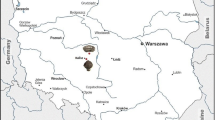Abstract
This paper presents a new non-destructive sampling method for the lead isotope analysis of lead objects using acidified cotton swabs. The results are indistinguishable within error margin from conventional sampling methods. This method was applied to a series of Sasanian lead coins from the Royal Museums of Art and History as well as a private collection. Elemental analysis was performed using micro-X-ray fluorescence. Isotopic analysis was performed using multi collector-inductively coupled plasma-mass spectrometry. Lead isotope analysis showed that at least four distinct sources of lead were used over time by the Sasanians to produce coins. Elemental analysis revealed three compositional groups distinct from the isotope groups, showing that a change in composition did not necessarily follow a change in raw materials supply. The uniformity of isotope compositions within particular periods, and of chemical composition across different mints, may point to a central control of both raw material supply and composition of Sasanian lead coins.






Similar content being viewed by others
References
Baron S, Cochet A (2003) Étude d'un lot de lingots de plomb antiques des Saintes-Maries-dela-Mer. Ségrégations et analyses chimiques élémentaires. Revue d’Archéométrie 27:147–163. https://doi.org/10.3406/arsci.2003.1051
Blet-Lemarquand M (2012) L’apport des analyses élémentaires des monnaies de la collection de Paris, Sylloge Nummorum Sasanidarum Paris-Berlin-Wien. Band II: Ohrmazd I – Ohrmazd II, 93–110
De Callatay F (2010) Monetary-type leads in ancient Greece: Coins (official, votive or counterfeit), tokens, seals, weights, proofs or fantasies? [Les plombs à types monétaires en Grèce ancienne: Monnaies (officielles, votives ou contrefaites), jetons, sceaux, poids, épreuves ou fantaisies?]. Revue Numismatique 166:219–255
De Muynck D, Cloquet C, Vanhaecke F (2008) Development of a new method for Pb isotopic analysis of archaeological artefacts using single-collector ICP-dynamic reaction cell-MS. J Anal Atom spectrom 23:62–71
Degryse P, Vanhaecke F (2016) Status and prospects for quasi-non-destructive analysis of ancient artefacts via LA-ICP-MS. Elements 12:341–346. https://doi.org/10.2113/gselements.12.5.341
Ehya F, Lotfi M, Rasa I (2010) Emarat carbonate-hosted Zn–Pb deposit, Markazi Province, Iran: a geological, mineralogical and isotopic (S, Pb) study. J Asian Earth Sci 37:186–194 https://doi.org/10.1016/j.jseaes.2009.08.007
Frame L (2010) Metallurgical investigations at Godin Tepe, Iran, Part I: the metal finds. J Archaeol Sci 37:1700–1715
Galer SJG, Abouchami W (1998) Practical application of lead triple spiking for correction of instrumental mass discrimination. Mineral Mag 62A:491–492
Ghorbani M (2013) The economic geology of Iran: mineral deposits and natural resources. (pp. 1–569) https://doi.org/10.1007/978-94-007-5625-0
Gomes SS, Soares AM, Araújo MF, Correia VH (2016) Lead isotopes and elemental composition of Roman fistulae plumbeae aquariae from Conimbriga (Portugal) using Quadrupole ICP-MS. Microchem J 129:184–193. https://doi.org/10.1016/j.microc.2016.06.027
Gyselen R, Mochiri MI (2017) Une collection de monnaies Sassanides de billon, de cuivre et de plomb. Res Orientales XXVI:9–106
L’Heritier M, Baron S, Cassayre L, Téreygeol F (2015) Bismuth behaviour during ancient processes of silver-lead production. J Archaeol Sci 57:56–68
L'Héritier M, Arles A, Disser A, Gratuze B (2016) Lead it be! Identifying the construction phases of gothic cathedrals using lead analysis by LA-ICP-MS. J Archaeol Sci Rep 6:252–265. https://doi.org/10.1016/j.jasrep.2016.02.017
Meliksetian K, Pernicka E, Badalyan R, Avetissyan P (2003) Geochemical characterisation of Armenian Early Bronze Age metal artefacts and their relation to copper ores. In: International conference: Archaeometallurgy in Europe. 24.–26. September 2003, Milan, Italy. Associazione Italiana di Metallurgia 1 (Milano 2003) 597–606
Meyers P (2003) Production of silver in antiquity: ore type identified based upon elemental compositions of ancient silver artifacts, Patterns and process. A Festschrift in honor of Dr. Edward V. Sayre, 271–288
Mirnejad H, Simonetti A, Molasalehi F (2011) Pb isotopic compositions of some Zn–Pb deposits and occurrences from Urumieh–Dokhtar and Sanandaj–Sirjan zones in Iran. Ore Geol Rev 39:181–187
Momenzadeh M (2004) Metallic mineral resources of Iran, mined in ancient times. A brief review. In: Stöllner T, Slotta R, Vantandoust A (eds) Persia’s ancient splendor (Persiens Antike Pracht): mining, handicraft and archaeology, Bochum, pp 8–21
Nezafati N, Pernicka E, Momenzadeh M (2008) Iranian ore deposits and their role in the development of ancient cultures. Anschnitt 21:77–90
Pike, A. (2002) Appendix: analysis of Caucasian metalwork – the use of antimonal, arsenical and tin. in: Curtis, J., Kruszyński, M. Ancient Caucasian and related material in the British Museum, London , p. 87–91
Roustaei K (2012) Archaeo-mettalurgical reconnaissance of ancient mines and slag sites on the northern edge of the Dasht-E Kavir Desert, Iran. Iran Antiq XLVII:351–398
Schindel N (2015) Sasanidische Bleimünzen. In: Szaivert W, Schindel N, Beckers M, Vondrovec K (Eds.) Toyto Apech TH XWPA. Festschrift für Wolfgang Hahn zum 70. Geburtstag, Wien, pp.303–330
Stos-Gale Z, Gale NH (2009) Metal provenancing using isotopes and the Oxford archaeological lead isotope database (OXALID). Archaeol Anthropol Sci 1:195–213
Van Ham-Meert A, Overlaet B, Claeys P, Degryse P (2017) The use of μXRF for the elemental analysis of sasanian lead coins from the collections of the royal museums of art and history in Brussels. Res Orientales XXVI:121–128
Acknowledgements
The authors are grateful to the RMAH for allowing the analysis of the samples and to Mr. François Gurnet for kindly lending his coins.
Funding
The research is funded by an FWO grant (G.0C43.15). The authors are grateful for the Hercules funding which allowed the purchase of the μXRF.
Author information
Authors and Affiliations
Corresponding author
Additional information
Publisher’s Note
Springer Nature remains neutral with regard to jurisdictional claims in published maps and institutional affiliations.
Rights and permissions
About this article
Cite this article
Van Ham-Meert, A., Rademakers, F.W., Claeys, P. et al. Novel analytical protocols for elemental and isotopic analysis of lead coins—Sasanian lead coins as a case study. Archaeol Anthropol Sci 11, 3375–3388 (2019). https://doi.org/10.1007/s12520-018-0758-8
Received:
Accepted:
Published:
Issue Date:
DOI: https://doi.org/10.1007/s12520-018-0758-8




